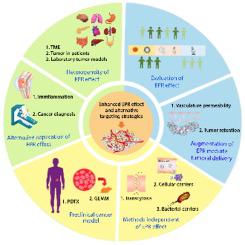Advanced Drug Delivery Reviews ( IF 15.2 ) Pub Date : 2022-07-11 , DOI: 10.1016/j.addr.2022.114449 Yixuan Zi 1 , Kaiyun Yang 2 , Jianhua He 1 , Zimei Wu 2 , Jianping Liu 1 , Wenli Zhang 1

|
在过去的几十年中,增强的渗透性和保留 (EPR) 效应已被公认为肿瘤靶向递送的中心范例。在这个概念之后,纳米技术在研究中已经达到了惊人的水平。然而,临床肿瘤显示 EPR 效应的表现不佳。肿瘤异质性、复杂的肿瘤微环境以及实验室模型与人类肿瘤之间的差异等因素在很大程度上导致了肿瘤靶向递送效率低下和临床转化治疗失败。在本文中,概述了评估 EPR 在人类肿瘤中的作用的方法,作为将 EPR 作用用于癌症治疗的指导。在不同方面讨论了增强 EPR 介导的肿瘤递送的策略,包括增强血管通透性,肿瘤细胞外基质的消耗和纳米颗粒设计的优化。此外,重点介绍了替代肿瘤靶向递送机制的最新发展,包括跨内皮途径、内源性细胞载体和非免疫原性细菌介导的递送。此外,还引入了更好地反映人类肿瘤的新兴临床前模型。最后,提出了EPR效应在其他疾病和领域更合理的应用。本文阐述了理论预期与临床结果之间存在差距的根本原因,试图为癌症纳米药物在这个仍在发展的环境中的未来发展提供一些前景方向。强调了替代肿瘤靶向递送机制的最新发展,包括跨内皮途径、内源性细胞载体和非免疫原性细菌介导的递送。此外,还引入了更好地反映人类肿瘤的新兴临床前模型。最后,提出了EPR效应在其他疾病和领域更合理的应用。本文阐述了理论预期与临床结果之间存在差距的根本原因,试图为癌症纳米药物在这个仍在发展的环境中的未来发展提供一些前景方向。强调了替代肿瘤靶向递送机制的最新发展,包括跨内皮途径、内源性细胞载体和非免疫原性细菌介导的递送。此外,还引入了更好地反映人类肿瘤的新兴临床前模型。最后,提出了EPR效应在其他疾病和领域更合理的应用。本文阐述了理论预期与临床结果之间存在差距的根本原因,试图为癌症纳米药物在这个仍在发展的环境中的未来发展提供一些前景方向。提出了EPR效应在其他疾病和领域更合理的应用。本文阐述了理论预期与临床结果之间存在差距的根本原因,试图为癌症纳米药物在这个仍在发展的环境中的未来发展提供一些前景方向。提出了EPR效应在其他疾病和领域更合理的应用。本文阐述了理论预期与临床结果之间存在差距的根本原因,试图为癌症纳米药物在这个仍在发展的环境中的未来发展提供一些前景方向。

"点击查看英文标题和摘要"































 京公网安备 11010802027423号
京公网安备 11010802027423号